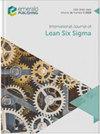Axiomatic design for lean autonomous maintenance system: an application from textile industry
IF 3.7
2区 工程技术
Q2 ENGINEERING, INDUSTRIAL
引用次数: 0
Abstract
Purpose Autonomous maintenance (AM), one of the pillars of total productive maintenance (TPM), aims to achieve performance toward zero defects and zero breakdowns. AM system equipped with comprehensive lean tools provides continuous improvement during the AM activities. Despite its long duration, establishing a lean AM system with a robust guideline would provide significant benefits such as high quality and short lead time. Therefore, AM design approach should be provided in a holistic and detailed manner. This study aims to develop a framework for AM design, including preliminary, reactive, preventive and proactive steps using the axiomatic design (AD). Design/methodology/approach Requirements and technical parameters of the AM system are explored with AD. An extensive literature review and a real-life application are presented. Findings The proposed design was validated by adapting the proposed roadmap to a textile manufacturing system in Turkey. The application results justify the established AM system design with an average downtime improvement of 69.2% and the average elapsed time between two failures improvement of 65.1% for apparel department. Originality/value This study has the novelty of establishing an overall AM system design with all of its stages stepwise. It presents a comprehensive guideline in terms of integration of lean philosophy into AM design by generating maintenance-related use cases for lean tools. The developed approach facilitates creating and analyzing complex systems to improve maintenance implementations while reducing nonvalue-added operations.精益自主维修系统的公理设计:纺织工业的应用
目的自主维护(AM)是全面生产性维护(TPM)的支柱之一,旨在实现零缺陷和零故障的性能。配备全面精益工具的AM系统在AM活动期间提供持续改进。尽管持续时间很长,但建立一个具有稳健指导方针的精益AM系统将带来显著的好处,如高质量和短交付周期。因此,AM设计方法应以全面和详细的方式提供。本研究旨在开发AM设计的框架,包括使用公理设计(AD)的初步、反应、预防和主动步骤。设计/方法论/方法用AD探索AM系统的要求和技术参数。介绍了广泛的文献综述和实际应用。发现通过将拟议的路线图调整为土耳其的纺织制造系统,对拟议的设计进行了验证。应用结果证明了所建立的AM系统设计的合理性,服装部门的平均停机时间提高了69.2%,两次故障之间的平均运行时间提高了65.1%。独创性/价值本研究的新颖之处在于建立了一个完整的AM系统设计,其所有阶段都是循序渐进的。它通过生成精益工具的维护相关用例,提供了一个将精益哲学集成到AM设计中的全面指南。所开发的方法有助于创建和分析复杂系统,以改进维护实施,同时减少非增值操作。
本文章由计算机程序翻译,如有差异,请以英文原文为准。
求助全文
约1分钟内获得全文
求助全文
来源期刊

International Journal of Lean Six Sigma
Engineering-Industrial and Manufacturing Engineering
CiteScore
8.90
自引率
15.00%
发文量
46
期刊介绍:
Launched in 2010, International Journal of Lean Six Sigma publishes original, empirical and review papers, case studies and theoretical frameworks or models related to Lean and Six Sigma methodologies. High quality submissions are sought from academics, researchers, practitioners and leading management consultants from around the world. Research, case studies and examples can be cited from manufacturing, service and public sectors. This includes manufacturing, health, financial services, local government, education, professional services, IT Services, transport, etc.
 求助内容:
求助内容: 应助结果提醒方式:
应助结果提醒方式:


